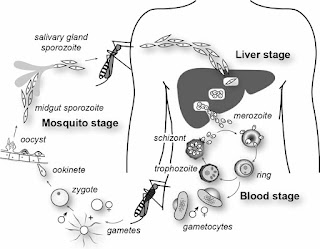Disease - MALARIA
MALARIA
- Pathogen: Plasmodium. (P. vivax, P. malarilae, P. ovale, P. falciparum)
Malignant malaria caused by P. falciparum is fata.
- Organs affected: liver, RBC. Method of transmission: by biting of female anopheles mosquito (vector)
- Symptoms: high fever and chill, fever occurs on every alternate day, vomiting.
- life cycle of malaria parasite: Life cycle of plasmodium starts with inoculation of sporozoites (infective stage) through the bite of infected female Anopheles mosquitoes. The parasite initially multiplied within the liver cells and then attack the red blood cells (RBCs) resulting in their rupture. There is release of a toxic substance called hemozoin from the ruptured RBCs which responsible for the chill and high fever. From the infected human the parasite enters into the body of Anopheles mosquito during biting and sucking blood. Further development takes place in the body of Anopheles mosquitoes. The female mosquito takes up gametocytes with the blood meal. Formation of gametes and fertilization takes place in the intestine of mosquito. The zygote develops further and forms thousands of sporozoites which migrated into the salivary gland of mosquito. When the mosquito bite another human sporozoites are injected. The malarial parasite requires two hosts human and Anopheles, to complete their life cycle.


Very helpfull
ReplyDelete👍👍👍👍👍
ReplyDeleteThk u
ReplyDeleteNice
ReplyDelete
ReplyDelete